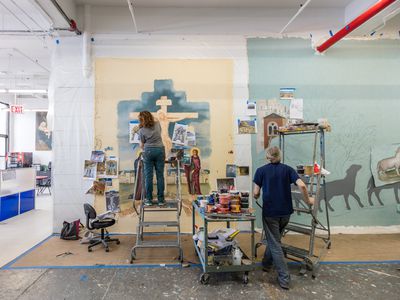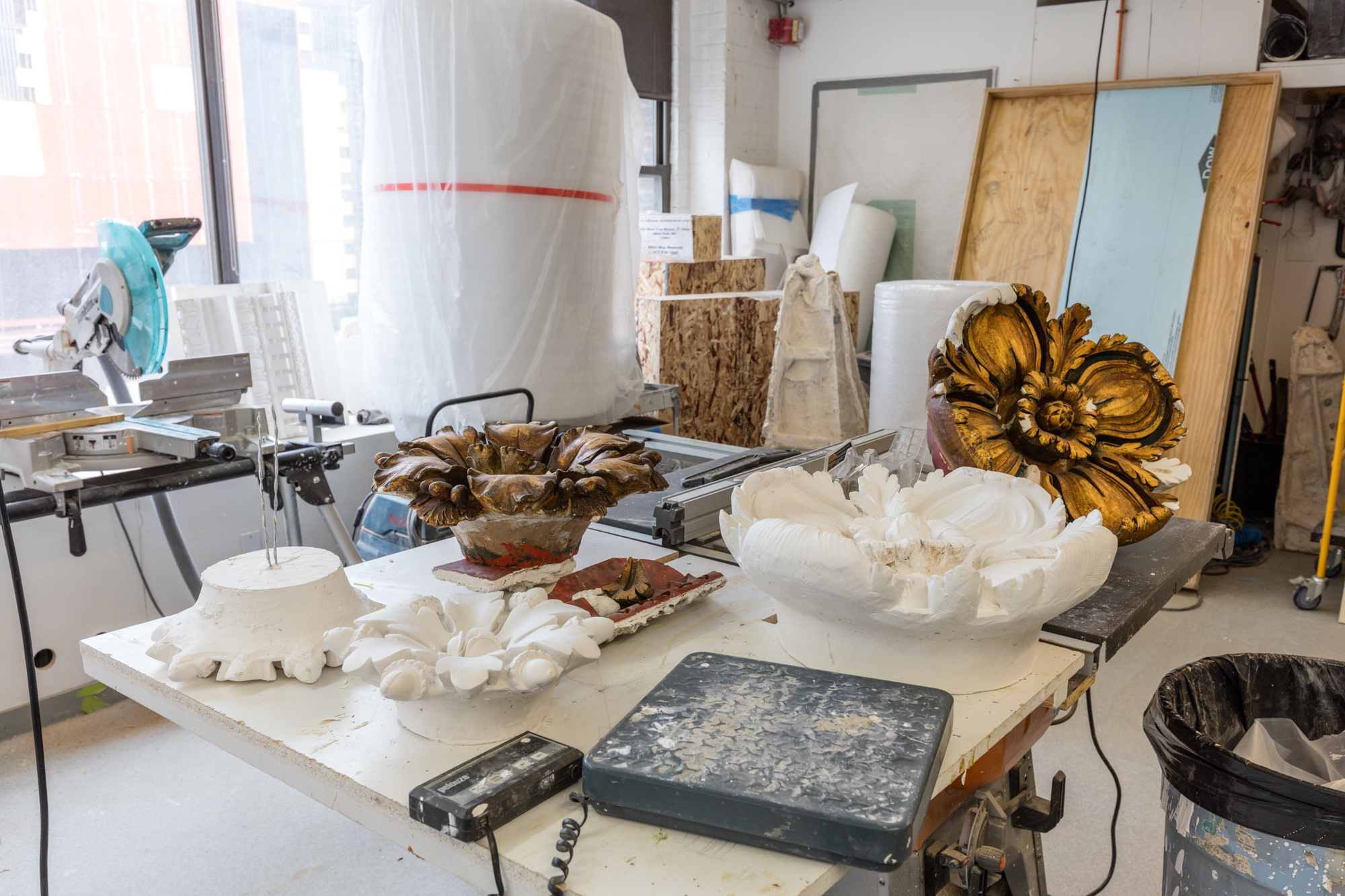
Even if you don't know the name EverGreene Architectural Arts, there's a good chance that you know the firm's work. It would be difficult not to; the firm, founded in 1978, has been involved in the care and upkeep of some of the country's most recognizable landmarks, both in New York City and beyond.
The gilded Art Deco mural that now lines the lobby of the Empire State Building? That was EverGreene. The massive undertaking that was restoring the dilapidated King's Theatre in Brooklyn? EverGreene was involved in that, too; the firm spent countless hours cleaning the neglected movie house, replicating bits of decorative plaster, and repainting the ceiling, all in the service of restoring the Wonder Theater it to its stunning pre-war glory. The Chrysler Building, Radio City Music Hall, the Sherry-Netherland Hotel: each of these landmark venues has, at some point, been carefully restored by EverGreene.
And its current roster of projects is equally high-profile: The firm is working on the restoration of the Rotunda of the U.S. Capitol building, Cleveland's historic Ohio Theatre, and the New York Public Library's soaring Rose Main Reading Room, among other historic structures. It recently completed the stunning overhaul of the Veterans Room at the Park Avenue Armory.
But for all of the high-profile projects it works on now, EverGreene has quite humble beginnings. Its founder, Jeff Greene, studied fine art at the Art Institute of Chicago in the hopes of becoming a muralist, but after graduating in 1976, he found himself painting billboards in Times Square. On weekends, he would make extra money by soliciting painting work elsewhere. "I would put these fliers in people's brownstones," he remembers. "I had a rigging license and a set of scaffoldings, and I wasn't afraid of heights. Most of the people who called me were foreigners who owned embassies or unions." As Greene's commissions rose, he decided to take the plunge and start his own company. "I was trained as an artist," he says. "I didn't know about payroll taxes, I didn't understand how these things worked. I really was quite naive, but there's something to be said for naivety."

EverGreene Architectural Arts founder Jeff Greene in his office near Hudson Yards. Photo by Max Touhey for Curbed.
Greene is sitting in his office at EverGreene's studio in Hell's Kitchen, situated directly across from the Manhattan West mixed-use project on one side, and the Hudson Yards megaproject on the other. The two are emblematic of the current wave of development throughout New York these days—cities-within-a-city comprising multiple glass monoliths—and are antithetical to the type of work that EverGreene is known for. (The firm won't be in its current space for long; according to Greene, they'll pack up and move to Industry City by the end of the year, joining a like-minded community of creative folks who now have offices there. "We're makers," he notes. "That's what we do.")
Indeed, the firm has gotten a reputation over the past three decades as one of the premier companies for historic preservation and conservation. It's thanks, in part, to Greene's interest in techniques and processes that may seem archaic—plaster restoration, for example, or mural-painting, where he got his start. The bookshelves in Greene's office are overstuffed with probably hundreds of tomes, some of which date to the 19th century and explain the methods behind things like etching and creating plaster. "I'm a bricks and mortar guy," he says by way of explanation.
But the work that EverGreene does isn't limited to merely burnishing old bronze or repainting centuries-old murals. Each job the firm tackles is one part history lesson, one part research project, and one part science experiment. "The first part is understanding the building," says Greene. "Listening to the building as closely as possible to understand all the layers, physical and otherwise, of what's going on." The starting point is often forensic research: examining a structure, identifying the materials that it's made from, and figuring out how best to repair—or replace—the existing parts. Depending on the project, EverGreene may then either step back as other firms implement their vision, or they'll be involved in the concept from start to finish. "Our preference is to carry projects all the way through," notes Greene. "Understand the project, understand its history, understand its use, understand its interpretation, and then articulate that vision."

Rosettes for the New York Public Library are replicated in EverGreene's plaster lab. Photo by Max Touhey for Curbed.
Take the Kings Theatre in Brooklyn, for example. According to Greene, EverGreene looked at the space "probably six times" before it joined the team working on the epic revamp of the 1929 Wonder Theater. Once the firm got involved, its restoration experts did everything from studying photographs of the theater in its heyday, to looking at bits of paint under a microscope to identify the various layers that had been added to the space in years since it opened.
Based on that research, the firm was able to figure out how to re-create the decorative elements that had been lost as the grand theater sat, decaying and unused, for more than three decades. Old, rotting plaster was ripped out, and new ornamentation was added in its place; the ornate ceilings in the lobby and auditorium were painstakingly replicated using paint swatches that were created to match the original ones. It's a stunning example of the processes EverGreene specializes in—not just historic restoration and preservation, but also plaster re-creation, gilding, woodwork, and more. "Everybody recognized the grandeur of the place, and they wanted to capture the magic," says Greene.
Even though the projects that EverGreene works on are different in size and scope, they're linked by a common theme: a deep reverence for the significance of these buildings—not just historically, though that's important too, but how they fit in within their communities. "In a country that is very homogenized now, what distinguishes any place from another is usually the physical landscape and the built environment," Greene says. "It represents what transpired there."
Many of the buildings that EverGreene has saved are both monumental and vernacular; they're impressive landmarks with gorgeous architecture, yes, but they're also deeply influenced by the communities they serve. It's that human element that especially interests Greene, and has driven much of his work with the firm over the past few decades. "The art of preservation is not a static activity," he explains. "It's a completely dynamic process that is ongoing and evolved. You don't just fix a building and then it's a monument; it's this interaction between the people who use it and perceive it." Whether it's a building like the U.S. Capitol or the New York Public Library, or a church serving a smaller community in Montana, the specialists at EverGreene keep the same questions in mind: Why was this building preserved? How was the space used originally, and how is it being used now? And how can they best preserve the building's history, while also respecting its current audience?
In the years since EverGreene was founded, the concept of historic preservation has gone from being what Greene calls an "elitist" activitiy—"the daughters of the American Revolution, that kind of stuff," he says—to a concern that's an inextricable part of urban planning and communities. It's a change that Greene welcomes. "I think preservation has been embraced by the public to a large degree, and that it's accessible at any level," he explains. "People understand it now: Why is our community special? Do beautiful buildings and the humanization of the built environment have the ability to change the way that we respond to all kinds of things? I think it's an influence." And it's what will keep the firm doing what it does best—bringing these historic buildings back to their former glory—for decades to come.
from
http://ny.curbed.com/2016/5/6/11583790/evergreene-architectural-arts-historic-preservation

No comments:
Post a Comment